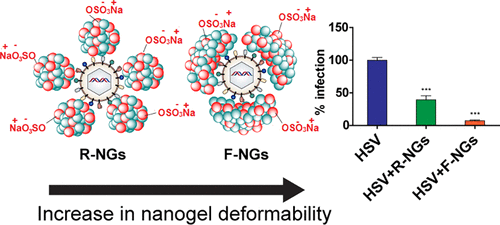Our official English website, www.x-mol.net, welcomes your feedback! (Note: you will need to create a separate account there.)
Multivalent Flexible Nanogels Exhibit Broad-Spectrum Antiviral Activity by Blocking Virus Entry
ACS Nano ( IF 17.1 ) Pub Date : 2018-06-12 00:00:00 , DOI: 10.1021/acsnano.8b01616 Pradip Dey 1, 2 , Tobias Bergmann 3 , Jose Luis Cuellar-Camacho 1 , Svenja Ehrmann 1 , Mohammad Suman Chowdhury 1 , Minze Zhang 3 , Ismail Dahmani 4 , Rainer Haag 1 , Walid Azab 3
ACS Nano ( IF 17.1 ) Pub Date : 2018-06-12 00:00:00 , DOI: 10.1021/acsnano.8b01616 Pradip Dey 1, 2 , Tobias Bergmann 3 , Jose Luis Cuellar-Camacho 1 , Svenja Ehrmann 1 , Mohammad Suman Chowdhury 1 , Minze Zhang 3 , Ismail Dahmani 4 , Rainer Haag 1 , Walid Azab 3
Affiliation

|
The entry process of viruses into host cells is complex and involves stable but transient multivalent interactions with different cell surface receptors. The initial contact of several viruses begins with attachment to heparan sulfate (HS) proteoglycans on the cell surface, which results in a cascade of events that end up with virus entry. The development of antiviral agents based on multivalent interactions to shield virus particles and block initial interactions with cellular receptors has attracted attention in antiviral research. Here, we designed nanogels with different degrees of flexibility based on dendritic polyglycerol sulfate to mimic cellular HS. The designed nanogels are nontoxic and broad-spectrum, can multivalently interact with viral glycoproteins, shield virus surfaces, and efficiently block infection. We also visualized virus–nanogel interactions as well as the uptake of nanogels by the cells through clathrin-mediated endocytosis using confocal microscopy. As many human viruses attach to the cells through HS moieties, we introduce our flexible nanogels as robust inhibitors for these viruses.
中文翻译:

多价柔性纳米凝胶通过阻止病毒进入展现出广谱的抗病毒活性
病毒进入宿主细胞的过程很复杂,涉及与不同细胞表面受体的稳定但短暂的多价相互作用。几种病毒的最初接触始于细胞表面硫酸乙酰肝素(HS)蛋白聚糖的附着,从而导致一系列事件,最终以病毒进入而告终。基于多价相互作用来屏蔽病毒颗粒并阻止与细胞受体的初始相互作用的抗病毒剂的开发引起了抗病毒研究的关注。在这里,我们基于树突状聚甘油硫酸盐模拟细胞HS设计了具有不同程度柔性的纳米凝胶。设计的纳米凝胶无毒且广谱,可以与病毒糖蛋白多价相互作用,屏蔽病毒表面,并有效地阻止感染。我们还使用共聚焦显微镜观察了病毒与纳米凝胶的相互作用以及细胞通过网格蛋白介导的内吞作用摄取的纳米凝胶。由于许多人类病毒通过HS部分附着在细胞上,因此我们引入了柔性纳米凝胶作为这些病毒的强大抑制剂。
更新日期:2018-06-12
中文翻译:

多价柔性纳米凝胶通过阻止病毒进入展现出广谱的抗病毒活性
病毒进入宿主细胞的过程很复杂,涉及与不同细胞表面受体的稳定但短暂的多价相互作用。几种病毒的最初接触始于细胞表面硫酸乙酰肝素(HS)蛋白聚糖的附着,从而导致一系列事件,最终以病毒进入而告终。基于多价相互作用来屏蔽病毒颗粒并阻止与细胞受体的初始相互作用的抗病毒剂的开发引起了抗病毒研究的关注。在这里,我们基于树突状聚甘油硫酸盐模拟细胞HS设计了具有不同程度柔性的纳米凝胶。设计的纳米凝胶无毒且广谱,可以与病毒糖蛋白多价相互作用,屏蔽病毒表面,并有效地阻止感染。我们还使用共聚焦显微镜观察了病毒与纳米凝胶的相互作用以及细胞通过网格蛋白介导的内吞作用摄取的纳米凝胶。由于许多人类病毒通过HS部分附着在细胞上,因此我们引入了柔性纳米凝胶作为这些病毒的强大抑制剂。



























 京公网安备 11010802027423号
京公网安备 11010802027423号